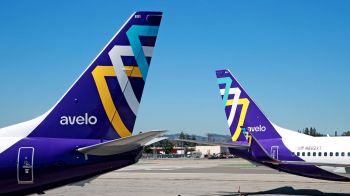
A brief history of airline bankruptcies

Spirit Airlines says it hopes to emerge from bankruptcy by the first quarter of 2025. Dozens of airlines have gone bankrupt over the years, and while some have recovered, others have shuttered or merged with other carriers.
Before the late 1970s, the airline industry was heavily regulated. There were just a handful of big carriers, and government officials essentially controlled the routes they could fly and the fares they could charge. And then in 1978, the Airline Deregulation Act changed all that.
“Essentially what happened is when it went into law, we saw just a flood of new airlines coming in,” said Daniel Bubb, an associate professor at the University of Nevada, Las Vegas.
“And their initiative, basically, was to undercut the major carriers and get them to drop their fares so that air travel could become more affordable,” he said.
Some of those older carriers, like Pan Am, couldn’t keep up and eventually went bankrupt or merged with others. Though, a lot of the smaller, upstart airlines of the 1980s didn’t last long either. That’s partly because running an airline involves a lot of guesswork, said Clifford Winston, a senior fellow at the Brookings Institution.
“They have to commit to capacity they’re going to offer — how many flights, how many seats, all that kind of stuff — before they know what the demand is going to be,” he said.
Which means if there’s a shock, like an “unanticipated recession, spike in fuel prices, they’re caught holding the bag,” Winston said.
That’s part of what led to another rash of airline bankruptcies among major airlines in the mid-2000s.
The September 11th attacks scared away passengers for a while and around the same time, a new group of low-cost airlines started gaining traction, said Richard Aboulafia, a managing director at Aerodynamic Advisory.
“You had the, you know, legacy carriers with all their overcapacity really being pressed downward on fares faster than they could reduce their costs. And as a consequence, there were bankruptcies, industry restructuring,” Aboulafia said.
A bunch of those legacy airlines ended up merging. Northwest joined with Delta, “American and US Airways, United and Continental. So six became three,” he said.
Meanwhile, budget airlines including Spirit started thriving, as long as their expenses remained low, Aboulafia said.
But in the years since the pandemic, labor costs, fuel and interest rates have been on the rise.
“And that makes it very difficult for the ultra low-cost carriers that never really learned how to profit from premium passengers,” he said.
Now, Aboulafia said it’s the legacy carriers that are doing well, since they can charge more for first-class seats and international flights. And it’s Spirit going to bankruptcy court.
There’s a lot happening in the world. Through it all, Marketplace is here for you.
You rely on Marketplace to break down the world’s events and tell you how it affects you in a fact-based, approachable way. We rely on your financial support to keep making that possible.
Your donation today powers the independent journalism that you rely on. For just $5/month, you can help sustain Marketplace so we can keep reporting on the things that matter to you.

















